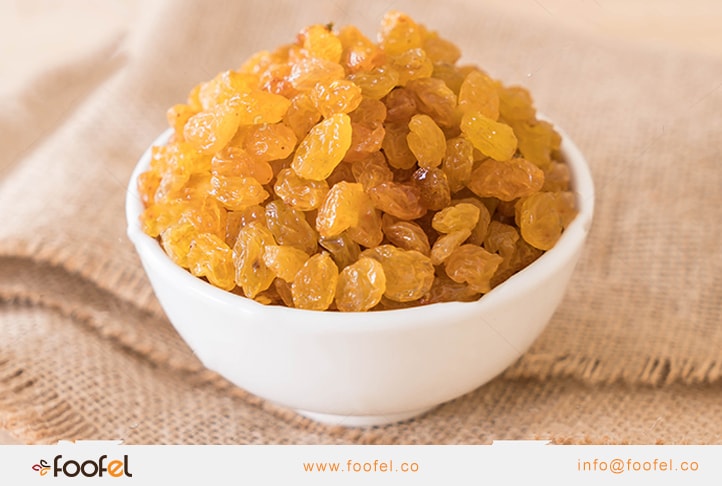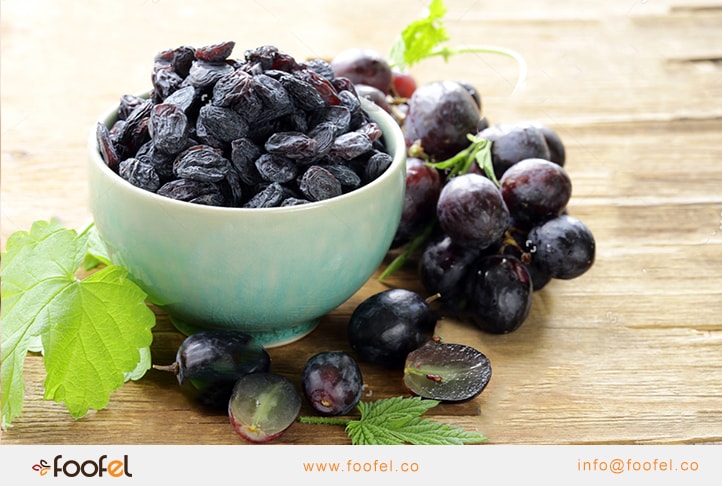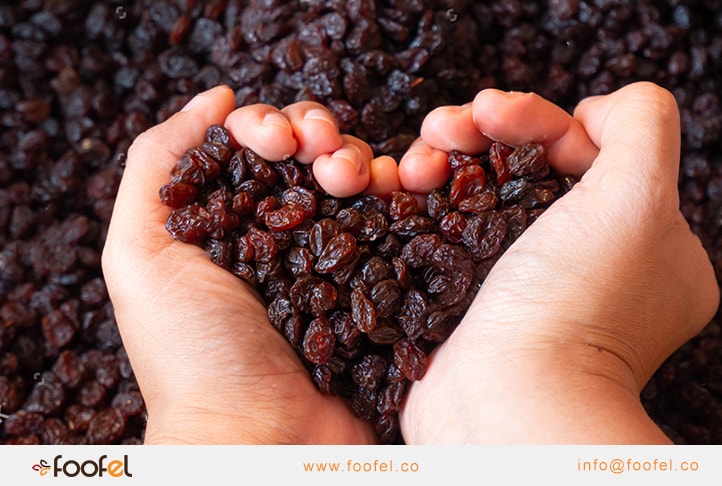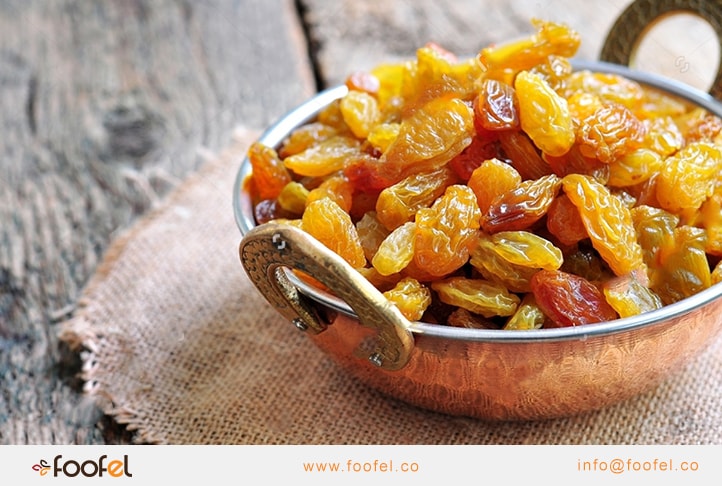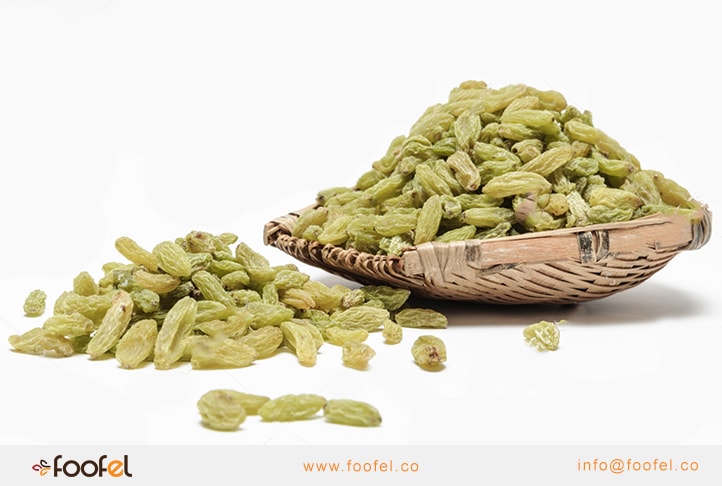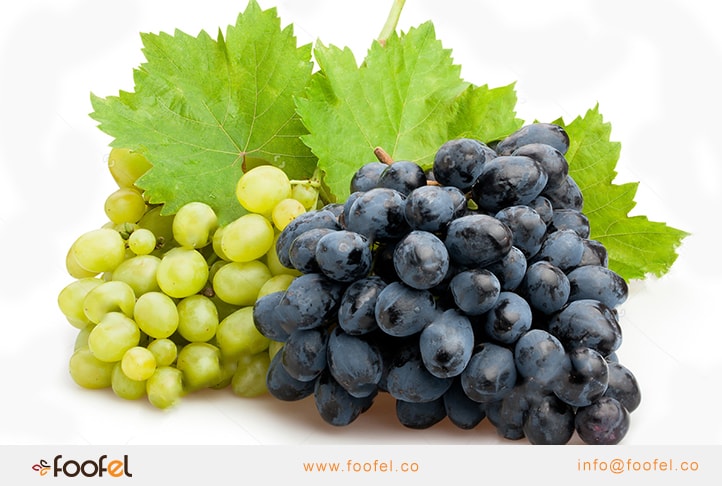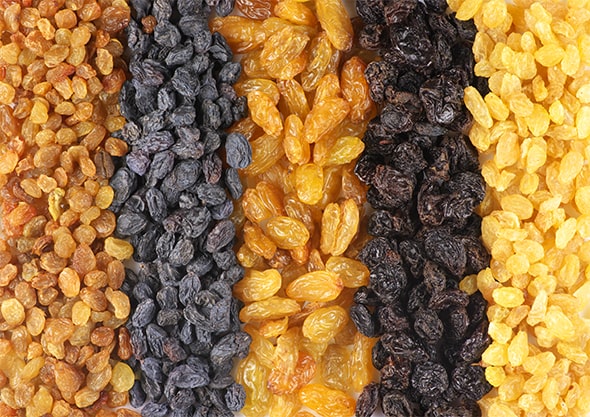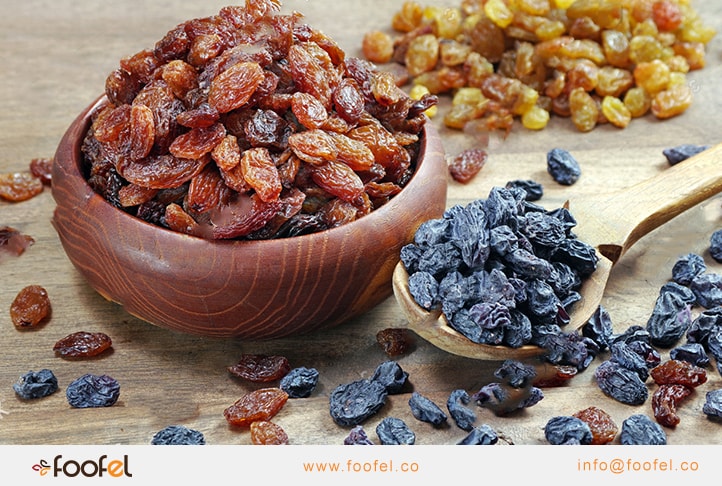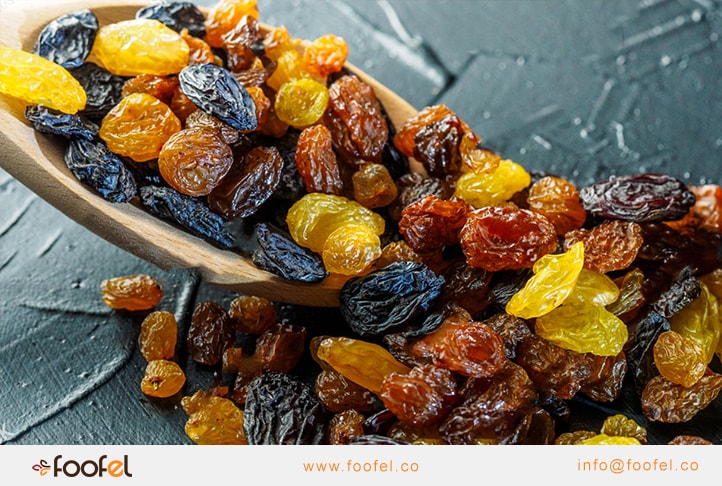
Iranian raisins for export
Iranian raisins for export
Iranian raisins for export raisins have given our country the third place to send to other countries, followed by Turkey and the United States. As you know, raisins are the same as dried grapes, and in the Iranian market, all kinds of export raisins can be found depending on the type of grapes, the drying conditions and the additives. Also, due to the possibility of long-term storage of this product in dry and cool conditions, it is possible to buy and sell exported raisins throughout the year.
How to achieve the highest quality raisins for export?
The first thing you need to know about the quality of exported raisins is that the best type of raisin product is obtained by drying ripe grapes in the open air (in the sun or in the shade) and without adding any chemicals or sulfur. In this article, you will get acquainted with the main cities producing raisins in Iran, how to prepare this product for export, the main purposes of sending export raisins and the types of raisins produced in our country.
Do you know the types of raisins that are produced in our country?
All types of raisins have their own advantages and features, which make this product very popular among domestic and foreign customers. Reducing blood pressure, helping to treat anemia, protecting bones, preventing cancer, providing the vitamins needed, improving vascular function and counteracting stomach problems are just a few of the many benefits of raisins. In this part of the article, you will learn about the types of raisins exported and the strengths of each.
Maviz raisins as export raisins:
maviz raisins have two main types, granular and seedless, and come in a variety of colors, from light yellow to yellowish brown. Alkaline permitted additives are used in the drying process of acid raisins.
Soltana raisins:
This type of raisin is obtained from a type of grape with small grains and is usually bought and sold for use in pilaf. Soltana raisin is a product of Takestan city and Iran sends this raisin to other countries and uses it as an export raisin.
Solar raisins as export raisins:
This type of raisin is obtained by drying the ripe fruit of various seedless grapes in direct sunlight. The exported raisins are brown.
Golden raisins:
Sulfur smoke is used to dry this type of exported raisin, and golden raisins are sold in amber yellow and light brown.
Kashmari raisin:
In our country, the most famous raisin is the same type of green pen that is used as a snack and in nuts. Green raisins are the result of drying grape seeds, long and stretched using sulfur.
Maviz Raisins:
Raisins or raisins are obtained from royal grapes and are smaller and darker in color than normal raisins and have a sharper taste.
What methods are used to produce exported raisins in Iran?
Raisins are mainly prepared by two general traditional and industrial methods. In the traditional method, the grape seeds are placed in large trays and exposed to direct sunlight. However, it is important to know that preparing raisins in the traditional way is not an easy task, and proper air conditioning plays a very important role in the process.
The industrial form involves dipping grapes in hot water or using sulfur vapor and other materials to produce raisins. Due to the caramelization of the sugar in the grapes, the raisins obtained in the traditional way are usually darker in color than the original grapes. However, if the industrial method of preparing raisins is used, the color of raisins will be golden and more colorful due to the use of sulfur gas.
Raisins are effective in treating cancer!
The transformation of grapes into raisins increases the concentration of phenolic compounds in this fruit and increases its cancer prevention and treatment properties. These phenolic compounds include quinic acid, gallic, chlorogenic, caffeic acid, catechin and epicatechin. Also, contrary to what may seem at first glance, golden raisins have more nutrients than traditional raisins.
Because sulfur antioxidants protect the beneficial compounds of grapes and do not allow the drying process to affect these properties. Exported raisins are offered in three common packaging methods: bulk supply and sale in export packaging.
What are the characteristics of premium exported raisins?
Good quality raisins are available without any odors or unnatural flavors, as well as free of pests and sand. High quality exported raisins have a moisture content of less than 18.% of the weight and an amount of sulfur anhydride and sulfur smoke less than two thousandths of a weight.
The quality of raisins also depends on the quality of the grapes. In fact, the best type of raisin is exported from a grape that is 80% ripe, and its color should be as uniform as possible. Another important factor in the quality of exported raisins is the lower number of brewed, unripe, small, crushed and sugared raisins than the number of healthy raisins in a certain amount, which is directly related to the process of cleaning raisins.
Which cities in Iran are leading in terms of raisin production?
Production of raisins for export from different grape varieties has been done by farmers all over the country, and this product, in addition to being used in cooking, is also consumed with nuts.
- Takestan
- Kashmir
- Buin Zahra
- Quchan
- Malekan
They have the first ranks in terms of producing the best types of raisins in our country, but the highest quality of raisins is related to the city of Malayer.
What is the current situation of raisin exports in our country?
Export of raisins in Iran has a history of several hundred years, and our country ranks first in the world in terms of diversity and variety of exported raisins. In fact, pistachio exports, raisin exports and date exports make up the bulk of Iran’s dried fruit exports. Currently, more than 80% of raisin exports in the world are made by Iran, Turkey, the United States, Greece and Chile.
On the other hand, most of the world’s raisins are imported from the United Arab Emirates, Russia, Ukraine, Germany, Egypt, Canada, Pakistan, Turkey, Spain and Kuwait. It is also interesting to note that Turkey and the UAE, although they are among the countries producing and exporting raisins, also import these goods.
Australia is also repackaging Iran’s raisins and then shipping them to other regions with its own brands. Iran’s climate and climatic conditions have made it one of the top rankings in horticulture, especially in grape cultivation and raisin production.
Germany, Germany, the United Arab Emirates and Australia are among the main importers of Iranian raisins, and Turkey, the United States and Greece are among Iran’s most important competitors in raisin exports.
Golden raisins for export
- Golden raisins are one of the most popular and popular types of raisins due to their special color and appearance, as well as the regular customers who always want them.
- For export to specific countries and luxury uses, golden raisins can be washed at least twice and sorted and packaged in very high quality.
- Iran is one of the most well-known countries in the field of golden raisin production and exports this type of raisin to European countries and the Persian Gulf countries.
- Egypt and Pakistan are also new customers in this field, and paying attention to them is a positive step in the export of Iranian golden raisins.
Exported raisins
Plum raisins are another export raisin and have their own applicants around the world. Due to the high quality of this product, Takestan plum raisins are very popular among importing countries and are mainly sent to Russia, Ukraine, Thailand, Malaysia and Indonesia.
Kashmari Export Raisins
Drying grapes in indoor halls creates a green color in this type of exported raisins and has benefits such as improving eye health, strengthening nerves, promoting dental and gum health, preventing osteoporosis and benefits for growing children, this raisin It has become one of the most famous. Saudi Arabia, Germany, Japan, Turkey, Turkmenistan and Iraq are the main export destinations for raisins.
Sharp export raisins
Sharp raisins are of lower quality than sun raisins than green raisins, and therefore more affordable. The presence of vitamin A, vitamin B, vitamin C, omega-3 and omega-6 has made this type of raisin one of the best-selling varieties.
This exported raisin has the highest production in the cities and provinces of Bojnourd, Islamshahr, Kashmar, Bushehr and Sistan and Baluchestan, and it is possible to buy it, whether in bulk or in packages in most parts of the country.
What are the important features of buying and selling raisins for export?
You can buy and sell exported raisins by searching newspaper ads, social media, searching on Google, and asking marketers or dried fruit vendors around the city.
In the production of raisins for export, the quality of grapes and the method of drying and processing are the two main factors determining the quality of the product. But there are requirements that export raisins must meet in order to be shipped to other countries.
Features such as soillessness and pollution, cleanliness from any pests, taste quality, controlled humidity and the presence of low chemicals in a product make it a good choice for export. For example, the best type of sharp raisins has 20% moisture.
How do you succeed in buying and selling raisins?
Iranian raisins Companies working in the field of raisin production or processing of exported raisins should always keep in mind that the condition for their success in global markets is new marketing methods and communication with the consumer market.
Market analysis and special strategies for raisin exports and export cooperation agreements are the leading levers for exporting raisins to countries. Another important factor in the success of buying and selling exported raisins is the type of product packaging. High quality raisins in beautiful and unique packaging attract the attention of foreign customers.
One of the factors that can introduce the products of countries in the field of selling raisins for export to world markets is participating in international food exhibitions that are held every year in different countries.
Despite all the advantages mentioned above, and given the huge share of raisin exports, there are problems and challenges in this competitive market.
- Allocate global markets to buy the products of a particular country
- Political and economic strategies of the producers of this product
- packaging method
- Issuance of health and business certificates
- Lack of suitable processing devices
- And classification in some countries
- Currency price fluctuations
There are examples of problems affecting the raisin market.
6 important tips for buying different types of raisins for export via the Internet:
- Check the price of your desired product on various sites and social networks.
- Compare these prices.
- In addition to the price, pay attention to factors such as the quality of exported raisins, how they are produced and the type of grapes.
- Check the delivery time and make sure it is convenient.
- When registering an order, pay attention to the possibility of returning the goods.
- Before finalizing your order, make sure the seller’s site is valid.
At what price are exported raisins sold?
The first thing to keep in mind about the price of raisins for export is that the price of this product for exporters is different from the price offered to domestic sellers. Of course, these prices vary depending on the exchange rate, the production process, the purchase price of the grapes, and how the packaging and supply are different, and depending on these factors, they will have different numbers.
Applicants can use the wholesale sales of raisins, producers, gardeners and farmers, and the stores that supply the product to get the exact price of raisins for export as well as for domestic consumption.
What are the top countries in the field of buying and selling raisins for export?
Turkey and the United States are among the world’s top raisin exporters. Buying, selling and exporting raisins as one of the important foods with therapeutic, medicinal and nutritional benefits for human health is one of the sources of income for the countries producing this food.
Raisins are obtained from grapes. In the process of exporting raisins, producers pack raisins, which are green, gold or black, for export after the grapes have dried. At present, raisins are one of the most important and main non-oil exports in the world, accounting for a significant percentage of the world’s exports in terms of revenue.
Turkey’s share in raisin exports
Turkey is known as the homeland of grape fruit. The history of grape planting in Turkey dates back to the 8th century AD. It currently produces about 4 million tons of grapes over an area of 550,000 hectares. About 37% of the grapes harvested in Turkey are dried and then turned into raisins. A higher percentage is used to produce juices and other processed products.
The Aegean Basin in Turkey offers the best conditions for grape cultivation. Raisin processing factories produce raisins from dried grapes in two ways: direct use of sunlight or using industrial dryers. they do. Turkey exports raisins to more than 100 countries, including the Netherlands, the United Kingdom, Italy, France and Australia.
US share in raisin exports
Exported raisins are one of the most important dry foods in the United States. Raisins have different brands in the United States, and a variety of raisins are produced, especially in the state of California.
More than 300 tons of raisins worth more than $ 700 million are produced in the United States. California’s land for grape cultivation to export raisins is about 280,000 hectares. The United States has a market share of more than 140,000 tons of raisins.
Iran’s share in raisin exports
Iranian raisins Iran is one of the countries active in the field of buying and selling raisins for export. Iran’s share of raisin exports is about 27 percent of world exports. More than $ 250 million is generated annually from this source of income.
Iran’s high quality raisins are exported to countries around the world such as Australia, the United Kingdom, the United States, Italy and France. More than 120,000 tons of raisins are produced annually in Iran with excellent quality. Iranian raisins include golden, green and black raisins.
kinds of raisins
Iranian raisins are a delicious dried fruit. This food is used in the preparation of a variety of foods, sweets, cookies, cakes and many other ingredients. You may have eaten the most delicious birthday cakes or homemade cakes that use a variety of raisins.
This product will be one of the sources of income for the countries producing and growing raisins and raisins. Iran also has the best opportunities to grow all kinds of raisins for export. Daily consumption of some iranian raisins in the diet can provide many vitamins and minerals for the health of the body.
Exported raisins contain vitamin C, vitamin B6, nutritious ions such as iron, magnesium, potassium and calcium. Eating raisins daily for children and at school can increase the energy needed to learn. These foods are sweet-tasting dried fruits that also look beautiful.
If you go to the market to buy exported raisins, you will come across a variety of raisin varieties, each with a different appearance and color. In fact, the market for raisins is very booming. Due to the price of raisins exported in international markets, many foreign countries are applying to buy Iranian raisins.
Some types of exported raisins have a dark brown color and others have a light color. You can make the most delicious recipes for special types of rice using a variety of pilaf raisins. Which is a symbol of delicious food on the Iranian table.
Various steps are taken to prepare and prepare different types of raisins, especially for export purposes to foreign countries. Raisins are actually made from grapes. In order to better determine the stages of preparation of raisins, we will deal with this issue in the next section.
Preparation of export raisins
When the grapes reach full growth, they are removed from the tree and exposed to sunlight on a flat surface without contamination. Under these conditions, all the moisture in the grapes is removed and, so to speak, dried. In this case, the color of the grapes, which in this case is called raisins, changes to brown.
The process of preparing all kinds of exported raisins can be produced in black, gold, red, green and brown colors. If some of the additives are added to the export raisins during the preparation process, the color of the raisins will change. This delicious ingredient is a flavoring for a variety of sweets, cakes and desserts or various dishes. It is also produced in various packages to be marketed.
Each type of raisin on the market has a different price, and depending on the location of the raisins and the areas where the grape trees are grown, as well as all the processes that take place to produce raisins, the price of raisins exported per capita. Kg, is different. Some types of raisins, such as plum raisins, are cheaper. In contrast, priced raisins and grape raisins are more expensive than other conventional raisins.



